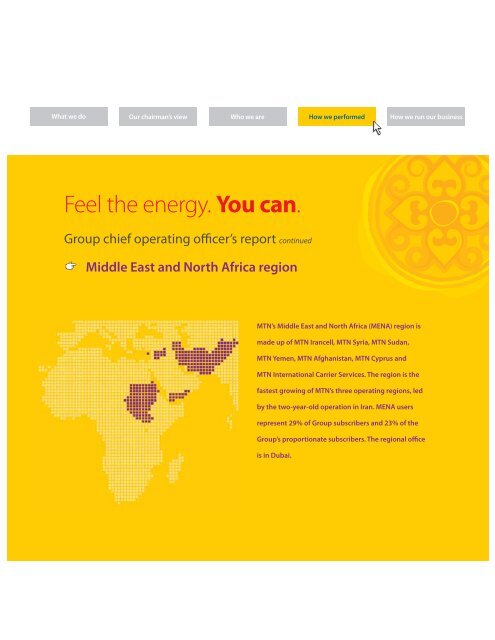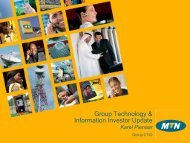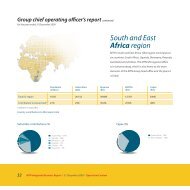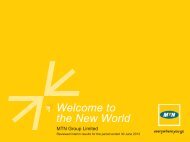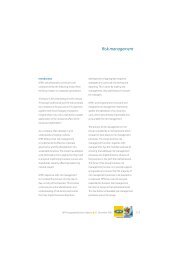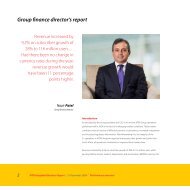Middle East and North Africa region - MTN Group
Middle East and North Africa region - MTN Group
Middle East and North Africa region - MTN Group
Create successful ePaper yourself
Turn your PDF publications into a flip-book with our unique Google optimized e-Paper software.
What we do Our chairman’s viewWho we are How we performed How we run our business<strong>Group</strong> balance sheetat 31 December 2008Feel the energy. You can.<strong>Group</strong> chief operating officer’s report continued<strong>Middle</strong> <strong>East</strong> <strong>and</strong> <strong>North</strong> <strong>Africa</strong> <strong>region</strong><strong>MTN</strong>’s <strong>Middle</strong> <strong>East</strong> <strong>and</strong> <strong>North</strong> <strong>Africa</strong> (MENA) <strong>region</strong> ismade up of <strong>MTN</strong> Irancell, <strong>MTN</strong> Syria, <strong>MTN</strong> Sudan,<strong>MTN</strong> Yemen, <strong>MTN</strong> Afghanistan, <strong>MTN</strong> Cyprus <strong>and</strong><strong>MTN</strong> International Carrier Services. The <strong>region</strong> is thefastest growing of <strong>MTN</strong>’s three operating <strong>region</strong>s, ledby the two-year-old operation in Iran. MENA usersrepresent 29% of <strong>Group</strong> subscribers <strong>and</strong> 23% of the<strong>Group</strong>’s proportionate subscribers. The <strong>region</strong>al officeis in Dubai.
54/55<strong>MTN</strong> Integrated Business Report 31 December 2008
What we do Our chairman’s viewWho we are How we performed How we run our business<strong>Group</strong> chief operating officer’s report continued<strong>Middle</strong> <strong>East</strong> <strong>and</strong> <strong>North</strong> <strong>Africa</strong> <strong>region</strong>al overview<strong>Middle</strong> <strong>East</strong> <strong>and</strong> <strong>North</strong> <strong>Africa</strong> <strong>region</strong>al contribution to <strong>Group</strong> totalPopulation(million)Subscribers (000)Revenue(Rm)EBITDA(Rm)Capex(Rm)Total 26 346 17 215 4 654 5 772% of <strong>Group</strong> total 36% 29% 17% 11% 21%Country contributions to MENA <strong>region</strong> totalSubscriber contribution %CapexIran 61%Syria 13%Sudan 10%Afghanistan 8%Iran 47%Syria 18%Sudan 16%Rest of <strong>region</strong> 19%Yemen 7%Cyprus 1%
PerformanceMost <strong>MTN</strong> operations in the MENA <strong>region</strong> performed wellin 2008, with subscriber numbers accelerating 88% to morethan 26,3 million at end-December 2008 driven mainly by Iran(details of which appear in the separate Iran report on page 59).This growth was underscored by improved infrastructure rollout in various markets. Our operation in Sudan (details of whichappear in the separate Sudan report on page 65) disappointed,mainly as a result of the disconnection of unregisteredsubscribers, as required by the regulator.Mobile penetration increased, but is still between 21% <strong>and</strong>23% in Sudan, Yemen <strong>and</strong> Afghanistan, which highlights theconsiderable opportunity that still exists for growth. Averagerevenue per user (ARPU) across MENA declined, except inCyprus, where blended ARPU increased to USD44 a monthfrom USD39 in 2007 mainly due to the proportion of postpaidsubscribers with higher ARPU's increasing from 27% to 35%.This market is at 90% penetration so ARPU stability is moreexpected. The increase was primarily due to the businessacquiring more postpaid subscribers at higher ARPUs.Competition is expected to increase as new licences areplanned for Iran <strong>and</strong> Syria.We rolled out various initiatives to create synergies between alloperating companies, by streamlining procedures, particularlyin human resources. <strong>Group</strong> events, such as Yell’o Stars <strong>and</strong> the<strong>Group</strong> Leadership Conference helped enhance the feeling ofbelonging <strong>and</strong> team spirit.We are pleased to report successful capex deployment acrossMENA. We started sharing infrastructure with some of ourcompetitors in 2008, <strong>and</strong> aim to increase this during the yearahead, with its favourable effect on our environmental footprint<strong>and</strong> costs. <strong>MTN</strong> Syria (details of which appear in the separateSyria report on page 62) replaced its core infrastructure duringthe year with new generation technology.Product <strong>and</strong> service delivery were a major focus area, withMENA operations working towards revamping <strong>MTN</strong>’s valueproposition to customers. This included preparations forMobile Money, dynamic tariffing, seamless roaming, customersegmentation <strong>and</strong> enhanced sales <strong>and</strong> distribution.56/57<strong>MTN</strong> Integrated Business Report 31 December 2008
What we do Our chairman’s viewWho we are How we performed How we run our business<strong>Group</strong> chief operating officer’s report continued<strong>Middle</strong> <strong>East</strong> <strong>and</strong> <strong>North</strong> <strong>Africa</strong> continued/<strong>MTN</strong> Irancell review<strong>MTN</strong> Afghanistan gained the number two position in themarket mainly as a result of aggressive roll out of the network<strong>and</strong> following the re-br<strong>and</strong>ing of operations in May. Thesesignificant achievements are notwithst<strong>and</strong>ing the numerouschallenges faced, among them, significant competition,security concerns, lack of basic infrastructure, a geographicallydifficult environment <strong>and</strong> periodically severe weatherconditions. Border closures from time to time also delayed thedelivery of materials, while recruiting sufficient skilled local staffremains a challenge.<strong>MTN</strong> Yemen maintained its market leadership throughout theyear, with 38% market share. The launch of the “talk free after thethird minute” offer proved to be particularly successful in Yemen,although the market responded well to most of our offerings.The employees of <strong>MTN</strong> Yemen won the <strong>Group</strong>’s joint first prize,with <strong>MTN</strong> Côte d’Ivoire, of the “21 days of Y’ello Care Challenge”,with the greatest staff participation in volunteering time <strong>and</strong>energies to support worthy projects in the community.know-how, as well as distribution support, <strong>and</strong> enable <strong>MTN</strong>Cyprus to offer comprehensive solutions for mobile, fixed <strong>and</strong>broadb<strong>and</strong> communications increasing its market share to amore healthy 19%.OutlookIn a challenging environment of ever-increasing competition,often-uncertain politics <strong>and</strong> evolving regulations,<strong>MTN</strong>’s operations in the MENA <strong>region</strong> will continue to strive togrow subscribers by rolling out new infrastructure, particularlyin rural areas, <strong>and</strong> introducing new products <strong>and</strong> services. The<strong>Group</strong> has authorised an increase in capital expenditure toR6,7 billion in the <strong>region</strong> in 2009, although this reflects only ourproportionate share of <strong>MTN</strong> Irancell’s capex.We will capitalise on the <strong>Group</strong>’s sponsorship of the2010 FIFA World Cup South <strong>Africa</strong> to further build our br<strong>and</strong>,while revamping our value proposition to customers <strong>and</strong>sharing learning across operating units.During the year <strong>MTN</strong> disposed of 49% of <strong>MTN</strong> Cyprus, selling astake to prominent Cypriot trading company, Amaracos, whohas a further option for 1%. At the same time, <strong>MTN</strong> Cyprusacquired 100% of fixed-line operator <strong>and</strong> internet serviceprovider, OTEnet, as well as retail chain, Infotel. Thesetransactions provide the operation with significant localWe will continue working to improve sales <strong>and</strong> distribution,<strong>and</strong> structure the retail network so as to limit churn <strong>and</strong> rewardgood distributors. Among a number of new products weplan to launch in the MENA <strong>region</strong> in 2009 are Mobile Money,<strong>MTN</strong> Zone dynamic tariffing <strong>and</strong> seamless roaming.
<strong>MTN</strong> IrancellLaunched October 2006, market share 37%, population71,9 million, forecast market size in 2013 – 53 million,shareholding 49%.Mobile penetration – Iran (%)70OverviewIn its second full year of operations, <strong>MTN</strong> Irancell movedsignificantly beyond a start-up project, taking more than halfof all net additions in the market. This brought total subscribernumbers to 16,04 million, up from six million – the largestannual increase in subscribers of any <strong>MTN</strong> operation, ever – <strong>and</strong>bolstered <strong>MTN</strong> Irancell’s market share to 37%, from 23% a yearearlier.56422820140Capex – Iran3 0006137Dec 07 Dec 08(R million)2 743Subscriber acquisition was driven by strong br<strong>and</strong> image,successful seasonal promotional campaigns <strong>and</strong> new products<strong>and</strong> services.Average revenue per user declined by USD1 to USD9 . This isdue to the sharp increase in the number of subscribers, whichnow includes many more lower-income customers, as well asthe depreciation of the rial against the dollar. Almost 98% ofour users are prepaid, while the rest are on postpaid plans, asignificant change from two years ago when the market wasalmost completely postpaid.2 2501 50075007731 559Dec 07 Dec 08Market environmentA steep fall in the price of oil – Iran’s key export – led to adrop in the value of the rial against the dollar <strong>and</strong> also stokedinflation, which at one stage reached more than 23% in theyear. Other reasons for the inflationary environment were Iran’sexpansionary monetary policy, fuel rationing <strong>and</strong> the liftingof some government subsidies on general consumer goods.58/59<strong>MTN</strong> Integrated Business Report 31 December 2008
Our main promotional activity was the “Buy One, Get One Free”campaign, driven largely by market research, which helpedboost br<strong>and</strong> awareness <strong>and</strong> lifted connection rates to anaverage of more than 31 000 a day for the year.of the local production of recharge cards (<strong>and</strong> plans to increasethis further); started the local production of SIM cards; <strong>and</strong> signedup two new local SIM kit-packaging suppliers, increasing thenumber of local suppliers, as well as local content.Competitive pricing of SIM packs, which lowered upfrontownership costs, combined with attractive basic <strong>and</strong>promotional tariff plans, contributed to subscriber growth. Newsegmented tariff plans, tailored to subscriber usage patterns,were also well received.Vitrin, <strong>MTN</strong> Irancell’s content portal, was launched at the start ofsummer as an innovative entertainment product. In an effort toimprove the customer experience, <strong>MTN</strong> Irancell launched threenew service centres during the year.Distribution<strong>MTN</strong> Irancell introduced a value-based channel strategy in theyear, providing distributors with a greater incentive to sell<strong>MTN</strong> packages. <strong>MTN</strong> Irancell now has 11 established distributorswith 5 980 registered dealers <strong>and</strong> approximately 64 000 points ofsale nationally. We also set up distribution through three bankswith more than 4 000 ATMs selling ‘logical PINs’ as well as twobanks selling prepaid airtime over the Internet.An efficient <strong>and</strong> cost-effective supply chain of warehousesensured that the right products, such as SIM <strong>and</strong> recharge cards,were available on dem<strong>and</strong>, even though sales during the yearexceeded forecasts. <strong>MTN</strong> Irancell more than doubled the capacityPeopleTo meet the needs of our rapidly exp<strong>and</strong>ing customer base<strong>and</strong> network, <strong>MTN</strong> Irancell doubled the number of peopleemployed during the year, although many were previouslycontractors working in a temporary capacity. <strong>MTN</strong>’s priority isto attract, recruit <strong>and</strong> retain people with the relevant skills <strong>and</strong>experience. We are also working on a customer-centric cultureprogramme to ensure excellent customer service.Regulatory environmentMany regulations in Iran are still being developed <strong>and</strong> thereis no overarching telecoms legislation or industry-specificregulations on issues such as interconnection <strong>and</strong> infrastructuresharing. During the year <strong>MTN</strong> Irancell continued to work onnegotiations with the Telecommunication Company of Iran(TCI) for an interconnect agreement.One of the main regulatory priorities for <strong>MTN</strong> Irancell is theregistration of users’ personal details, as required by law. Wehave equipped nearly 3 000 dealers with the means needed toregister subscribers.During the year, <strong>MTN</strong> Irancell was awarded a WiMax licenceas well as spectrum, <strong>and</strong> will commence WiMax services in60/61<strong>MTN</strong> Integrated Business Report 31 December 2008
What we do Our chairman’s viewWho we are How we performed How we run our business<strong>Group</strong> chief operating officer’s report continued<strong>MTN</strong> Irancell continued/<strong>MTN</strong> Syria review2009. We also received an ISP licence from the regulator <strong>and</strong>plan to roll out ISP services during the course of 2009. Iranrecently named the preferred bidder for a third mobile operatorlicence; however, it is not clear when the new entrant will startoperating.OutlookIn the year ahead we will continue to work hard towardsachieving critical mass <strong>and</strong> to firmly establish <strong>MTN</strong> Irancell’sposition in the market against an entrenched competitor aswell as the expected entry of a third operator.<strong>MTN</strong> SyriaLaunched June 2002, market share 46%, population20,4 million, forecast market size in 2013 – 13 million,shareholding 75%.Mobile penetration – Syria (%)403835322624Despite what we expect to be still-high inflation, we see strongpotential for growth in Iran, particularly in the more rural areas,where we intend to further extend our network. Our estimateof the addressable market in five years is 53 million subscribers.1680Dec 07 Dec 08<strong>MTN</strong> Irancell is also looking to penetrate the corporatesegment <strong>and</strong> to add total of around six million new customersto our network in 2009. We plan to achieve this through thelaunch of a series of innovations to leverage our technologicalleadership <strong>and</strong> stimulate usage. Improvements to customerservice, through segmentation, are a priority <strong>and</strong> we plan todevelop offerings that attract <strong>and</strong> retain users in the variousmarket segments.Capex – Syria1 200900600338300418(R million)1 0390Dec 07 Dec 08
Subscribers – Syria (000)4 0003 5393 1093 0002 2372 0001 0000Dec 07 Dec 08Overview<strong>MTN</strong> Syria increased its subscriber base by a moderate14% to 3,5 million in a year in which we replaced the coreinfrastructure with new-generation technology. The increasein user numbers was supported by a number of initiatives,including a reduction of prepaid tariffs during the last quarterof 2007; the extension of the validity periods for variousairtime packages; good management of churn <strong>and</strong> variouspromotional offers to the lower end of the market.The telecoms market in Syria is a managed one, where theregulator plays a significant role in market activities.ARPU – Syria252220152019(USD)The increasing trend by customers to move to prepaid frompostpaid contracts resulted in a drop in postpaid’s share oftotal subscribers to just under 16% from more than 18% a yearearlier. Blended average revenue per user declined USD1 toUSD19 as more subscribers in the lower-income segmentsjoined the network.105Market environmentThe Syrian economy experienced high inflation during the year,0Dec 07Dec 08which had a negative impact on the purchasing power of thelower-income users who make up about half of the <strong>MTN</strong> Syriasubscriber base. Delays in deliveries of network equipment,mainly a result of the process required to ensure compliancewith the US embargo on the country, affected roll out <strong>and</strong>hence network performance in the early part of the year.62/63<strong>MTN</strong> Integrated Business Report 31 December 2008
What we do Our chairman’s viewWho we are How we performed How we run our business<strong>Group</strong> chief operating officer’s report continued<strong>MTN</strong> Syria review continued/<strong>MTN</strong> Sudan reviewInfrastructureNetwork roll out gained momentum in the second half of thefinancial year <strong>and</strong> by year-end, <strong>MTN</strong> Syria’s legacy technology hadbeen replaced with a network based on the latest technology,providing a solid basis for growth. We migrated from a networkbased on time division multiplexing (TDM) to an Internet Protocolbackbone for the core network around four major cities. Werolled out 596 base transceiver stations in the year, bringing thetotal to 2 995. This included an acceleration of the rollout of our3G network, with 145 3G base transceiver stations constructedduring the year. Total capital expenditure more than doubled toover R1 billion in 2008.Products <strong>and</strong> servicesVoice remains the dominant application in Syria, with dem<strong>and</strong>for advanced data services still limited due to low Internetpenetration. Despite this, <strong>and</strong> with an eye to the future,<strong>MTN</strong> Syria acquired an ISP licence during the year, introducedenriched data offers <strong>and</strong> paved the way for full 3G services afterrunning a 3G trial project for the previous 18 months.GPRS tariffs were sharply reduced during the year, whilepromotions for SMS flat rates <strong>and</strong> various innovative servicestargeting the youth were launched. We upgraded the billingsystem to improve its efficiency <strong>and</strong> increase customer loyalty<strong>and</strong> also overhauled our customer contact centres to improvecustomer service, enhance our ability to h<strong>and</strong>le incoming calltraffic, increase productivity <strong>and</strong> reduce costs.DistributionImproved distribution remained a focus. We brought10 new franchise customer service centres into operationin geographically remote areas. <strong>MTN</strong> Syria also revisedcommission schemes <strong>and</strong> introduced electronic prepaidvouchers to the market, reaching a 38% penetration rate by theend of December 2008.PeopleAcknowledging the key competitive advantage that comesfrom our people, <strong>MTN</strong> Syria continued to invest in employeetraining during the year. More than four-fifths of all ouremployees attended at least one training course aimed atbuilding competencies <strong>and</strong> capabilities. We also put in place aclearly defined succession plan, identifying key leadership staff.Regulatory environment<strong>MTN</strong> Syria has a Build, Operate <strong>and</strong> Transfer (BOT) contract torun its mobile business. We continue to engage with the Syriantelecoms authorities to convert the BOT contract into a regularmobile operator licence.
Due to promulgation of certain laws <strong>and</strong> regulations in 2008,<strong>MTN</strong> Syria has been working to adjust its company by-laws <strong>and</strong>board of directors in order to comply with all the new laws <strong>and</strong>conditions.As the Syrian financial markets have only recently startedliberalising, foreign exchange legislation to allow for thepurchase of foreign currency is therefore still limited, a situationacknowledged by the Syrian authorities with whom wecontinue to engage.OutlookMobile penetration in Syria is around 38%, providing <strong>MTN</strong> Syria withmore opportunity to grow in a country of some 20 million people.We recently raised our forecast for the potential mobile market sizeto 13 million in five years’ time from a previous forecast of almost12 million. Changes in the regulatory environment are expectedto further drive penetration in the years ahead. <strong>MTN</strong> Syria expectsto add some 400 000 new subscribers in 2009 <strong>and</strong> increase data’scontribution to revenue due to the expected launch of commercial3G services in Syria.<strong>MTN</strong> SudanLaunched September 2005, market share 28%, population38,4 million, forecast market size in 2013 – 19 million,shareholding 85%.Mobile penetration – Sudan (%)252015105012Capex – Sudan1 0008002123Dec 07 Dec 08964(R million)9436006244002000Dec 07 Dec 0864/65<strong>MTN</strong> Integrated Business Report 31 December 2008
What we do Our chairman’s viewWho we are How we performed How we run our business<strong>Group</strong> chief operating officer’s report continued<strong>MTN</strong> Sudan review continuedSubscribers – Sudan (000)4 0003 0002 6472 0902 0001 0661 0000Dec 07 Dec 08OverviewIt was a difficult year for <strong>MTN</strong> Sudan in 2008, mainly as a resultof the regulator’s directive to disconnect more than 1,1 millionprepaid subscribers who had not registered their personaldetails <strong>and</strong> exacerbated by internal operational challengesin an environment of strong competition. Blended averagerevenue per user declined to USD7 in December 2008 fromUSD12 at the beginning of the year because of lower outgoingminutes of use. Subscriber net additions during the yeardropped to 557 000 from 1 024 000 in 2007.ARPU – Sudan252016151050127Dec 07 Dec 08(USD)On a positive note, however, we noted significant improvementsin the final quarter, with an increased number of subscribers, netadditions <strong>and</strong> revenue. A new chief executive was appointed inOctober <strong>and</strong> further senior management changes occurred inthe first quarter of 2009. Towards the end of the year, we regainedmarket share to 28%. However, our share of revenue still has to beimproved in line with subscriber share.Market environmentPolitical instability continues to be a challenge in Sudan; povertyis widespread <strong>and</strong> per capita income is low. However, with itssignificant oil resources, the economic potential of <strong>Africa</strong>’s largestcountry is considerable. Linked to this is the opportunity for growthin the telecoms sector, where mobile penetration increased to just23% in 2008 from 21% a year earlier. However, competition amongthe three main mobile operators in a country of around 38 millionpeople is fierce due to the h<strong>and</strong>set subsidisation <strong>and</strong> low tariffs ofthe CDMA operator.
InfrastructureThe roll out of new infrastructure continued during the year,particularly in southern Sudan. 424 base transceiver stationswere added to the network, bringing the total to 1 621.<strong>MTN</strong> Sudan’s network now covers 45,3% of the population,up from 42,8% at the end of 2007.In November, <strong>MTN</strong> Sudan put a new intelligent networkplatform into service, <strong>and</strong> also worked on implementing a swapof vendor for the core network. This enables the operation tooffer the best technologies to its customers (like <strong>MTN</strong> Zone)as well as allowing it to benefit from working on the sameplatform as other <strong>MTN</strong> operations.Products <strong>and</strong> servicesTo boost acquisitions <strong>and</strong> utilisation during the year, <strong>MTN</strong> Sudanlaunched a series of marketing activities, including focusing oncities outside the capital with low commercial coverage wherewe launched the Y’ello Storm campaign of special offers. Towardsyear-end we introduced “the 50% extra credit” campaign as well asa promotion to encourage international calls by giving away fourfree international minutes for every four international minutesused. With the start up of the new intelligent network platform,we prepared to launch dynamic tariffing with <strong>MTN</strong> Zone.Distribution<strong>MTN</strong> Sudan’s distributors have more than 8 500 points of salein the country. We have commenced work on revamping oursales <strong>and</strong> distribution channels, with opportunities identifiedbeyond greater Khartoum, in southern Sudan <strong>and</strong> across ruralareas. A key objective for 2009 is to increase our distributionfootprint significantly.People<strong>MTN</strong> Sudan implemented a new staff development <strong>and</strong>succession plan during the year to attract <strong>and</strong> retain key talent,<strong>and</strong> also revised remuneration to be in line with the market.<strong>MTN</strong> Sudan has a crisis management plan in place to ensurethe safety <strong>and</strong> security of our personnel in the current unstablepolitical environment.Regulatory environmentRegulation of the telecoms sector in Sudan is still evolving<strong>and</strong> is possibly not always adhered to equally by all operators.During the year we resolved an interconnect dispute with acompetitor <strong>and</strong> continued to work closely with the regulatoron what we believe to be anti-competitive pricing by otheroperators of international calls to other Arab countries.OutlookWe expect the size of the Sudanese telecoms market to growsignificantly in the next five years, to around 19 million from thecurrent 8,9 million. This will be driven by higher uptake in areasoutside the capital, Khartoum, where <strong>MTN</strong> Sudan continues toroll-out infrastructure. We intend to grow our share of mobilerevenue by growing our subscriber base. We also plan tolaunch 3G services shortly after our trial phase comes to anend. In February 2009 we inaugurated a new mobile switchingcentre in southern Sudan, underscoring our commitment toextend network coverage all over this <strong>region</strong>.66/67<strong>MTN</strong> Integrated Business Report 31 December 2008


